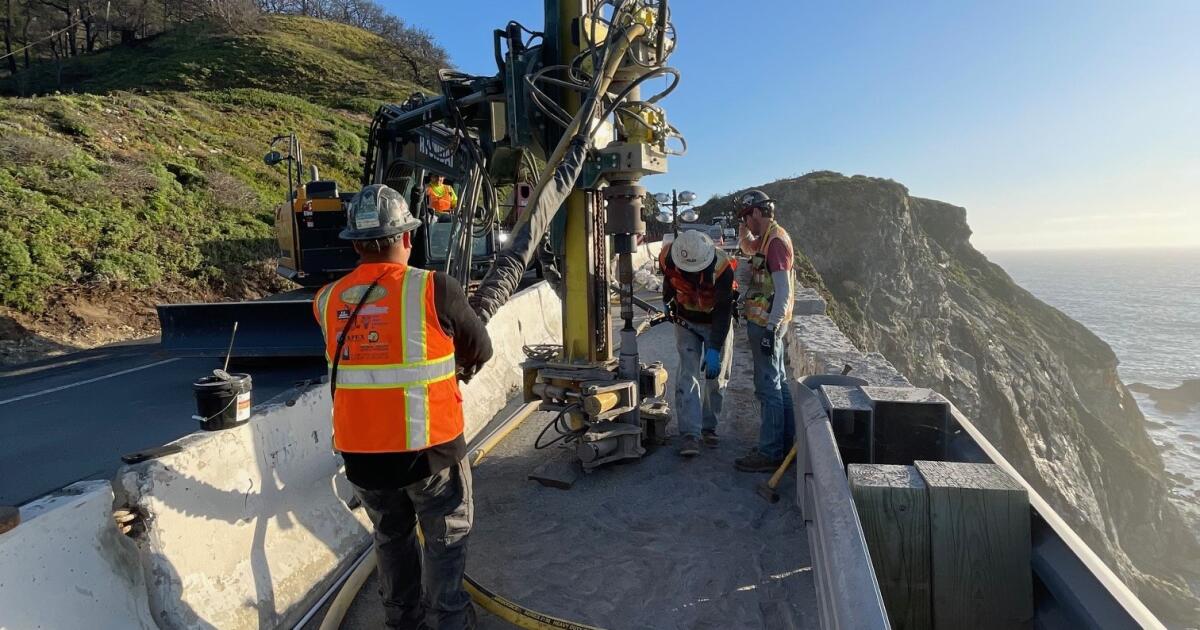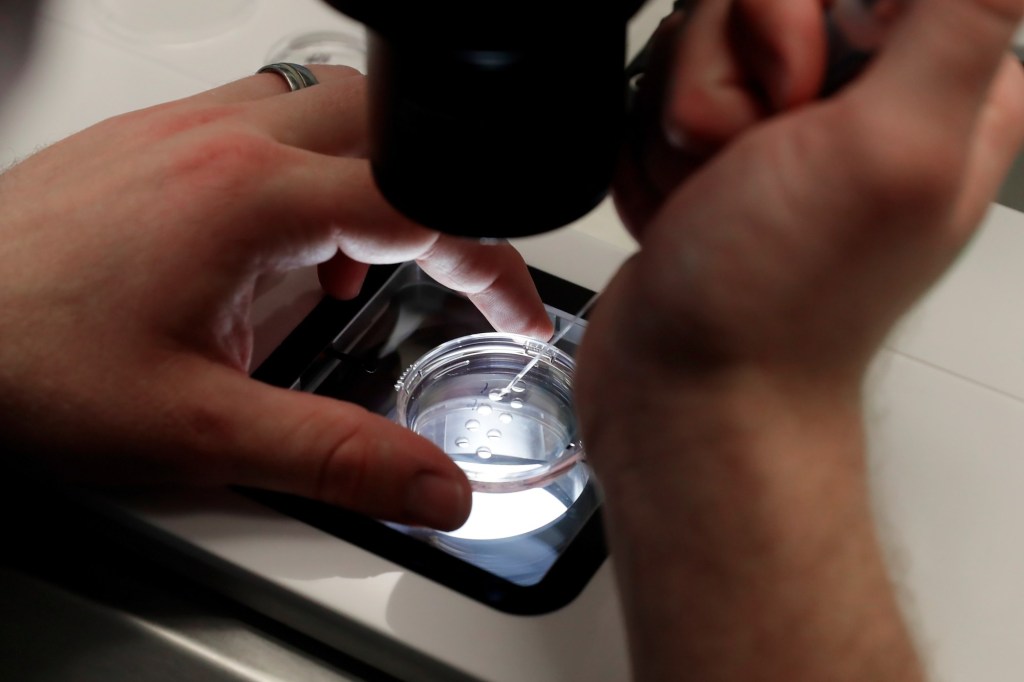Federal geologists blame the most recent collapse of Freeway 1 in Massive Sur on a comparatively frequent rockfall brought on by climate, waves and gravity that ultimately cracked the steep cliffside beneath the roadway, based on a brand new evaluation by the U.S. Geological Survey.
The excellent news is that researchers didn’t see a bigger landslide at work, which might counsel larger instability within the surrounding space. The unhealthy information is that it’s an ongoing problem to foretell the place and when one other rockfall may occur alongside Freeway 1 — the stretch of freeway that the USGS considers most susceptible to coastal erosion in California.
The March 30 slip-out that occurred simply south of Rocky Creek Bridge — the place a piece of the southbound lane fell into the ocean throughout a wet weekend — left a lot of the famous Big Sur coast cut off from the remainder of the state, with solely restricted convoys allowed by way of the broken stretch. A separate stretch of Freeway 1 — about 40 miles to the south — has been closed since January 2023, pounded by a string of landslides, together with one this winter.
“May I’ve informed you it was [going to be] Rocky Creek subsequent? No,” mentioned Jonathan Warrick, a USGS analysis geologist on the Pacific Coastal and Marine Science Heart in Santa Cruz. “We’re seeing numerous exercise, there’s simply numerous motion on the market. … Normally, what we are inclined to see alongside the Massive Sur coast, the wetter the winter, the extra of those rockfalls and landslides happen.”
California Division of Transportation officers recently announced the Rocky Creek Bridge part ought to reopen with unrestricted entry by Memorial Day. CalTrans officers are working to reopen simply the northbound lane, which was not broken in the course of the preliminary slip-out, for alternating one-lane visitors. Crews have been working for the reason that collapse to enhance stability, security options and drainage within the space.
Memorial Day “will likely be an enormous milestone as a result of it permits the 24/7 passage with out restriction” on the one lane, mentioned Kevin Drabinski, a CalTrans spokesperson. “We’ll be capable to open [the lane] up as soon as the sign is put in.”
Site visitors throughout that part has remained severely restricted, with twice-a-day convoys permitting locals and important staff by way of — and the convoys have been repeatedly canceled attributable to climate considerations.
“We all know how necessary Freeway 1 is to the regional economic system, particularly in the course of the summer season, so we’re working to reopen the roadway as rapidly and safely as attainable whereas on the similar time making it extra resilient to future excessive climate occasions,” Caltrans Director Tony Tavares mentioned in an announcement.
In contrast to what geologists discovered and proceed to watch in a number of different broken sections of Freeway 1, imaging from the Rocky Creek slip-out space didn’t reveal different close by land motion, based on preliminary pictures and evaluation revealed by the USGS this weekend. The brand new evaluation in contrast aerial pictures taken April 6 — a couple of days after the current injury — and Feb. 23.
“There wasn’t any apparent set off there,” Warrick mentioned. “It doesn’t have traits of a deeper-seated landslide, so far as we will inform but. … That’s form of a sigh of aid.”
U.S. Geological Survey animation of the Rocky Creek landslide that resulted in closure of California State Freeway 1.
(U.S. Geological Survey)
He mentioned rockfalls just like the one close to Rocky Creek Bridge are a pure a part of the coast’s erosion, however they may also be exacerbated by extra excessive local weather situations, together with notably moist seasons or wildfires. Although this winter in Massive Sur hasn’t been fairly as moist because the final, Warrick mentioned his workforce continues to be seeing motion on an analogous scale to what was recorded final 12 months.
“Water each provides weight and [acts as a] lubricant to the rocks on the market,” Warrick mentioned. “It’s occurring on the panorama that was already moist from final winter. … We’ve had two moist winters in a row, so we’re seeing fairly a little bit of hydrologic sliding.”
The Rocky Creek slip-out is just one of a number of areas that noticed destabilizing shifts and slides this moist winter and spring, including to a listing of susceptible websites alongside Massive Sur’s shoreline. For many years the USGS has been monitoring coastal cliff erosion alongside Massive Sur, and in recent times the company has been utilizing remote-sensing technologies and aerial imaging to higher doc, observe and analyze such coastal adjustments, in addition to inform state officers and residents of potential points.
In instances of deep-seated landslides, like Paul’s slide — positioned about 40 miles south of the Rocky Creek Bridge — Warrick mentioned his workforce has been capable of assist forecast new motion.
A piece of Freeway 1 close to Paul’s slide, simply north of Limekiln State Park, has been closed since final winter when the huge landslide buried the roadway. CalTrans officers are hopeful it may reopen by this summer season.
Building throughout the area, nonetheless, continues to be affected by inclement climate in addition to any new land motion. To this point, a minimum of, officers mentioned there hasn’t been any further motion across the website of the Rocky Creek Bridge collapse for the reason that preliminary slip-out.
Caltrans’ contractors just lately began work on extra long-term stabilization there, planning to drill vertical and horizontal helps deep into the cliffside. Crews have additionally constructed a concrete wall alongside the highway’s middle line to extend one-lane visitors security, and so they have improved drainage within the space, based on the company.
“The drainage enhancements may also assist the roadway higher stand up to excessive climate occasions, which have gotten extra frequent within the space attributable to local weather change,” CalTrans’ newest replace mentioned.
Whereas repairs plug alongside, Warrick mentioned the USGS will proceed to watch that spot, and plenty of alongside the shoreline.
“We see erosion virtually on the complete part of Massive Sur,” Warrick mentioned. “Are there areas which are particularly secure on Massive Sur? Not likely.”
The newest USGS images that doc adjustments during the last two months embrace before-and-after images from eight completely different websites, every of which recorded “substantial motion or potential for it to affect the freeway,” Warrick mentioned.
“It’s not only one website, it’s a complete handful of web sites,” he mentioned.
He mentioned his workforce will likely be out flying in a pair weeks to take extra pictures to watch and observe motion, particularly after rains have continued since their final pictures.
“Issues are nonetheless transferring on the market,” Warrick mentioned. “We’re going to maintain our eyes on that.”
Source link








